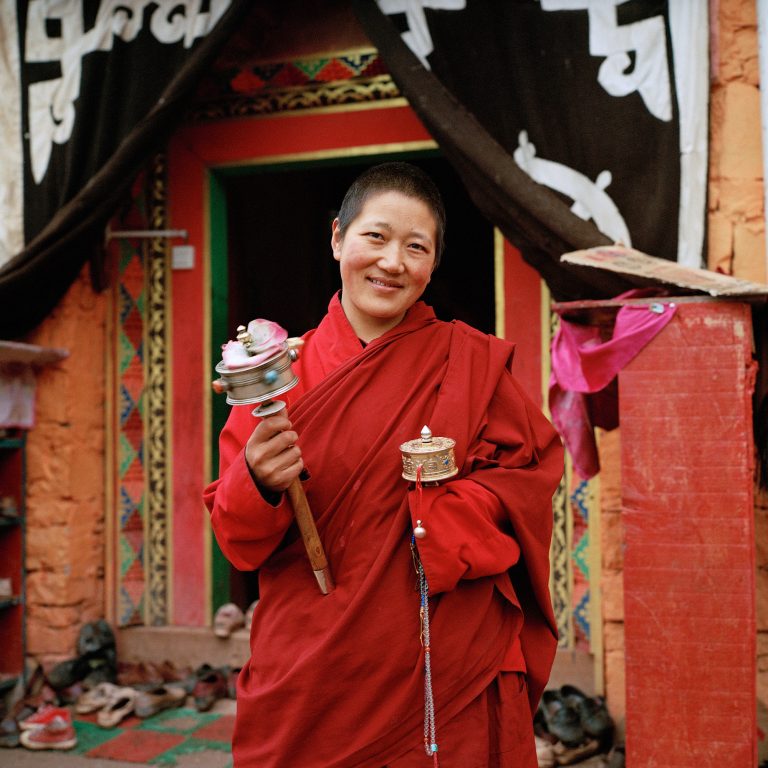
Tsoknyi Rinpoche’s nuns are part of a wisdom tradition long preserved in Tibet. In the 19th century, Tsoknyi Rinpoche the First designed and developed a system of practices for the transformation and enlightenment of female practitioners. He envisioned a time when these women would become among the most accomplished Buddhist practitioners in the world. The expression of Dharma through the female form is important and unique. Qualities such as gentleness, motherly care, and loving energy are quite strong in the female form and very healing for the world.
Schools & Education
Schools and education are the foundation of Tsoknyi Rinpoche’s efforts to cultivate opportunities for higher training, leadership, and service among women in the Himalaya. Tsoknyi Gechak School, outside of Kathmandu, was one of Tsoknyi Rinpoche’s earliest and most important projects to support the education and early development of young women.
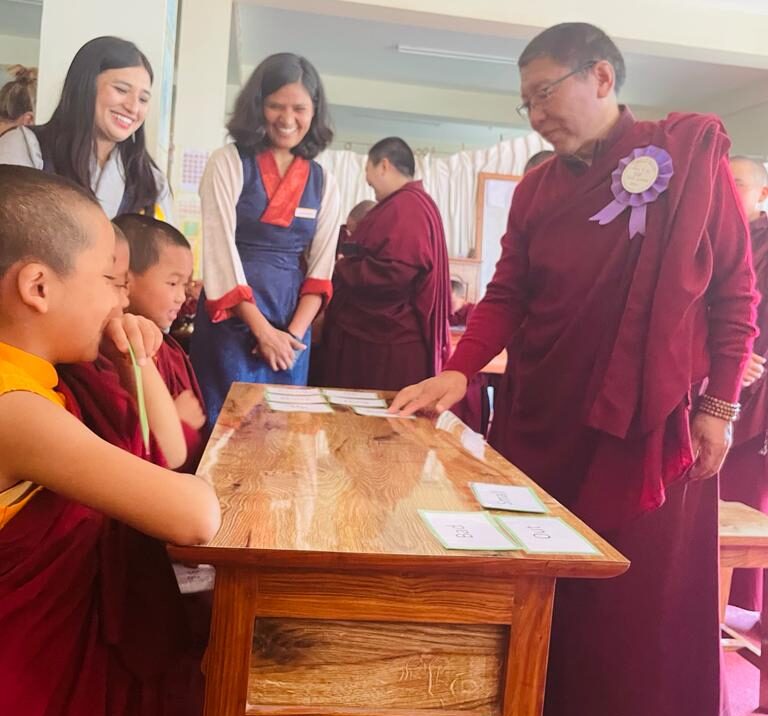
Tsoknyi Gechak School
Tsoknyi Gechak School is the primary and lower secondary school for the school-aged nuns at Tsoknyi Gechak Ling. Tsoknyi Gechak School combines the power of modern education and Buddhist spiritual training to cultivate students’ basic goodness and potential for compassion and wisdom. At TGS students follow the full Nepali government curriculum. This is enriched with field trips, art, mindfulness, project work and other creative activities and active learning techniques. Students simultaneously engage in traditional Buddhist monastic training. They learn ritual practices, meditation and memorize the sacred texts. For 2 years, the UNESCO award-winning Rato Bangala Foundation delivered a tailor-made teacher training program to TGS teaching staff. TGS now delivers it’s own in-house training program to new staff and continues to develop and grow with help from international mentors and friends.
Tsoknyi Gechak School has a Volunteer English Teacher program, for more details visit their website.
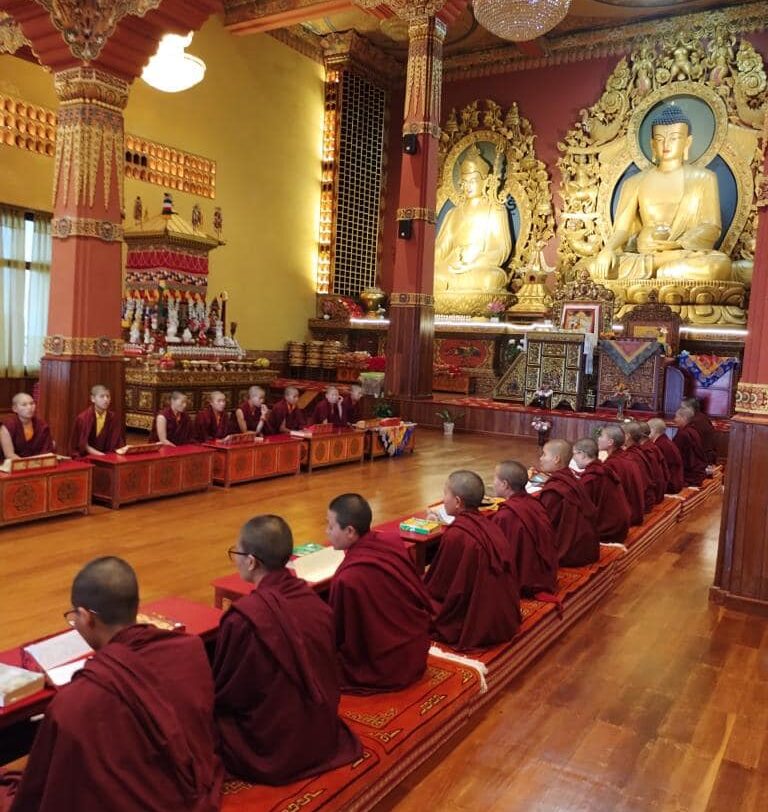
Nunneries: Tsoknyi Gechak Ling
Tsoknyi Gechak Ling is the only nunnery practicing the Tsoknyi tradition outside of Tibet. Located in the ancient hilltop village of Chobhar, outside of Kathmandu, which is renowned for the centuries-old temple of the Chobhar Adhinath, also known as Anandadi Lokeshvara, one of the Kathmandu Valley’s four main temples of Avalokiteshvara. The main shrine hall also holds an extraordinary image of thousand-armed Avalokiteshvara, lord of compassion. The practice of Avalokiteshvara has a very long history in this village, as it was here in the 9th century that the Buddhist nun Gelongma Palmo established the Nyungne purification practice of fasting and prayer focused on this very deity.
In addition, the village sits above the Chobhar Gorge, where according to legend the Bodhisattva Manjushri compassionately cut through the hills surrounding the Kathmandu Valley, opening what was previously a lake for human habitation.
Tsoknyi Gechak Ling opened in the spring of 2010 with about 32 nuns and is now home to well over 150 anis (Buddhist nuns). Many of the original nuns had come from Gechak Gonpa in Nangchen, eastern Tibet, to be with their teacher, Tsoknyi Rinpoche.
The first five nuns arrived in Kathmandu in 1994, and Rinpoche rented a house for them in Parphing, a place sacred to Guru Rinpoche just outside the Kathmandu valley. Over time their numbers increased, and they were joined by new young nuns from Nepal. Rinpoche arranged a larger residence and under his guidance, they practiced according to the Tsoknyi lineage tradition.
In 2009, the entire community moved to Chobhar in preparation for the opening of Tsoknyi Gechak Ling, where Rinpoche has also established a shedra to complete the nuns’ Buddhist philosophical education.
Later in 2010, Rinpoche visited his home village of Samagaon in Nubri, in the mountains of northern Nepal. He bestowed a public empowerment and helped inaugurate a joint community/government school. Rinpoche encouraged parents to send their children, including their daughters, to this school. He also mentioned that he had established a new nunnery in Kathmandu.
In the spring of 2011, 82 young girls arrived in Chobhar to join the gompa (nunnery). In a devout Himalayan Buddhist community like Nubri, many parents still prefer to send their children for a traditional Buddhist education rather than to a secular school. Faced with no place for the newcomers to stay, Rinpoche had to quickly turn a new administration building into dormitories and build temporary classroom space.
By the end of 2011, Rinpoche had created a vision to build a new nunnery at the Chobhar location as the current facilities were just too small for the number of nuns and young ani’s in residence. In early 2012 a Capital Campaign was started to raise funds from Rinpoche’s vision. Thanks to supporters from around the world, the nunnery now has a large and a small shrine hall, a primary and upper primary school, nuns residences, a shedra, the Pema Chödren three-year retreat building, and an international retreat center (still under construction).
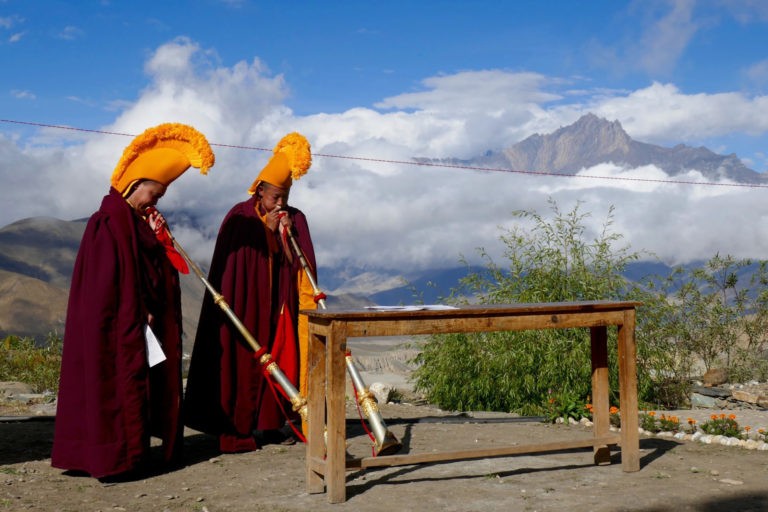
Nunneries: Tsoknyi Gargon Ling
Tsoknyi Gargon Ling is located high in the Himalayas at the sacred pilgrimage site of Muktinath, known to the Tibetans as Chumig Gyatsa, the place of a hundred springs. Both Buddhists and Hindus come to bathe in the holy water there. Sacred to the worship of Lord Vishnu, Muktinath is a place where all the elements come together, where fire blazes on earth, on rock, and on water. For Tibetan Buddhists, it is considered a place of Dakinis and a sacred supreme field for the accumulation of merit. Guru Rinpoche and many mahasiddhas visited and blessed the area. Sacred signs and imprints are visible in the rocks and hillsides.
The nunnery at Muktinath has been in existence for at least 400 years, but about 70 years ago, it was destroyed in a devastating fire, leaving the nuns without a home. In addition, after their lama had passed away, the nuns had to struggle for years to maintain their gonpa without the guidance of a lama and without any basic material support. Despite these difficulties, they continued praying as best they could in their rapidly disintegrating shrine room. In 1991, hearing of a great Tibetan lama of their own lineage, three senior nuns walked hundreds of miles over mountainous terrain to Kathmandu to request the spiritual and material help of Tsoknyi Rinpoche.
Rinpoche’s first visit to Tsoknyi Gargon Ling led to the immediate construction of 10 small rooms to accommodate some of the nuns. Since then, the nunnery has continued to be repaired and enlarged, adding a medical clinic, kitchen and dining hall. In a joyous celebration, during the full moon in October 2011, a grand new shrine hall was completed and inaugurated. Currently, the Muktinath anis divide their time between Muktinath and Tsoknyi Gechak Ling at Chobhar, where many study in the shedra or elementary school, and others practice in the Gargon Ling branch hermitage at Sitapaile, which will soon be used for nuns to carry out the traditional 3-year retreat practice.
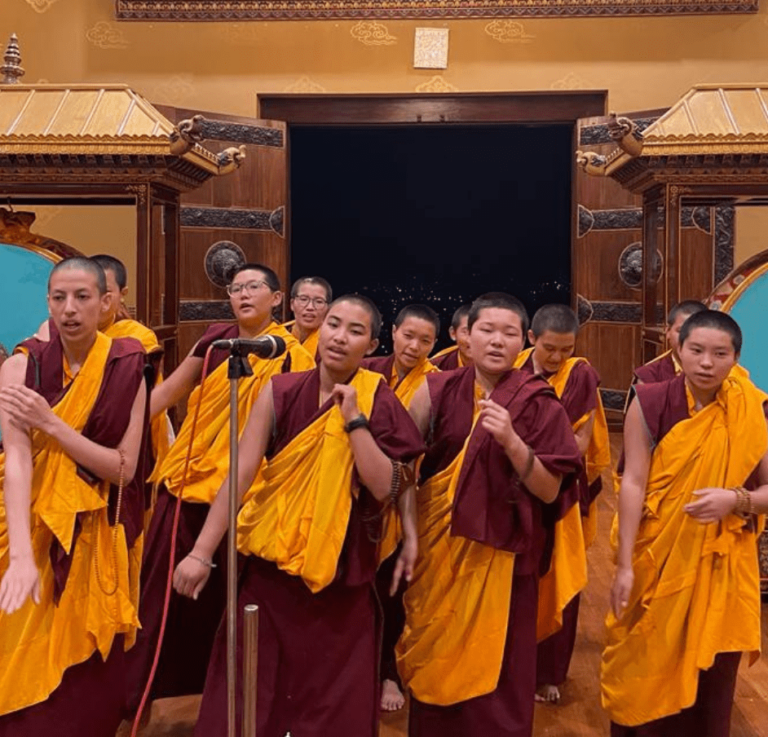
Leadership & Service
It has always been Tsoknyi Rinpoche’s aspiration that the nuns under his care have access to Tibetan Buddhist higher education (shedra) so that they can become teachers in their own right.
Tsoknyi Gechak Ling’s shedra offers a lengthy and detailed course of study in Buddhist philosophy. The Shedra follows the curriculum of Namdroling’s Ngagyur Nyingma’s Institute. Students follow a 9-year program. During the first four years the course covers five large Madhyamaka texts, two Abhidharma, three Tibetan language texts and several minor ones. In the fifth and sixth year, the course deals with the five works of Maitreya, Dharmakirti’s Pramana Vritti, an extensive study of Six Perfections with more emphasis on the Prajnaparamita (Perfection of Wisdom) and many other texts. The last three years of study is the Higher Tantra Course and includes Guna Prabha’s Vinaya treatise, Guhya Garbha Tantra, Longchen and Jigmed Lingpa’s works as well as Vinaya texts. The academic session runs from the beginning of the 2nd Tibetan month to the end of the 11th Tibetan month. Tsoknyi Gechak Ling’s Shedra currently has two class groups. The shedra has already graduated several classes of nuns!
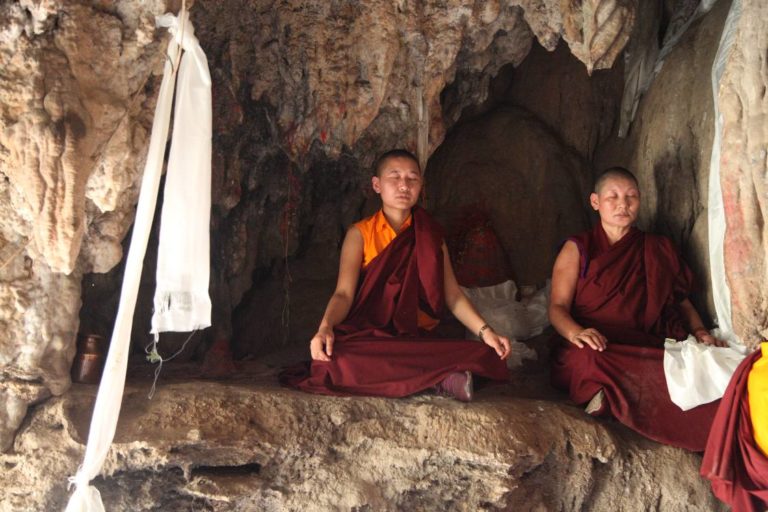
The Tsoknyi Lineages of Female Practitioners
From at least the 12th century, Tibetan nunneries assumed a key role in preserving the dharma in Tibet. Prior to 1949, there were at least 818 nunneries and approximately 28,000 nuns. In the years that followed, nunneries were destroyed and some nuns imprisoned, forced into labor camps and tortured. The devastation to the tradition of the Tsoknyi Lineage and the Nangchen Nuns was so extensive that the lineage was almost extinguished. In the mid-1980’s, a few surviving nuns began to rebuild and their numbers have grown to over 2,000 strong in Tibet.
Today, obstacles to practice and survival persist, driving nuns from Tibet into more accommodating countries such as Nepal. The journey out of Tibet is arduous; many of the nuns, ranging in age from pre-teen to old age, arrive penniless, with only the clothes on their backs. Once the nuns have left Tibet, they receive no familial or community support and are left to fend for themselves in a foreign country.
Five Nangchen Nuns from Tibet made this same journey in 1994, and over time twenty-three Nangchen Nuns arrived in Kathmandu, Nepal. While several of the nuns returned home to Nangchen, Tibet, leading members of the community remained in Nepal and moved to Chobar Hill to help Rinpoche create a home for the Tsoknyi Lineage outside of Tibet. Thanks to the generosity of Tsoknyi Rinpoche, their care was assured and they now form the core of Tsoknyi Gechak Ling, a monastic home in Kathmandu, Nepal where they can practice, study and grow in the Dharma. They have been joined by more nuns from Nepal and currently about 40 nuns and 82 girls live and practice at Tsoknyi Gechak Ling.
A similar story of need and generosity can be told of the Tsoknyi Gargon Ling nunnery high in the Himalayas at Muktinath. From a desperate situation in 1991, hearing of a great Tibetan lama of their own Drukpa Kagyu Lineage, three senior nuns walked hundreds of miles over mountainous terrain to Kathmandu to request the spiritual and material help of Tsoknyi Rinpoche. Twenty years later, housing, a kitchen, dining hall and a beautiful new Shrine Hall have been constructed. The October 2011 Consecration of Tsoknyi Gargon Ling was a joyous occasion attended by thousands of villagers, renowned teachers and students of Tsoknyi Rinpoche from around the world.
